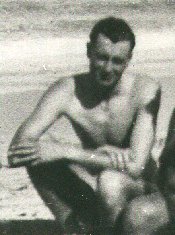13 SQUADRON RAAF
DURING WW2
![]()
On 1 June 1940 a number of personnel and "A" and "B" Flights of Avro Ansons Mark I's, were detached from 12 Squadron at Darwin in the Northern Territory, to form the new No. 13 Squadron RAAF. Their Commanding Officer was Flight Lieutenant J.R. Balmer.
13 Squadron took on a general reconnaissance role which including shipping patrols, searches for missing aircraft and general security patrols across the top end of Australia.
In November 1941 three Lockheed Hudsons from 13 Squadron assisted with the unsuccessful search for the Cruiser HMAS Sydney which had been sunk by the German shipping raider Kormoran.
With the threat of war with Japan, 13 Squadron RAAF was split into two groups, one detached flight of 6 Lockheed Hudsons was based at Laha on Ambon, with another at Namlea. On 23 December 1941 some Hudsons from 13 Squadron RAAF spotted a Japanese convoy at the northern end of the Celebes. By January 1942 their bases at Laha and Namlea were being frequently bombed by the Japanese. After suffering a number of losses and in February 1942 the remaining Hudsons returned to Darwin just in time for the first Japanese bombing raid on Darwin on 19 February 1942. Their Headquarters area, stores and spares were destroyed in the bombing raid. They temporarily withdrew their operations to Daly Waters. 13 Squadron RAAF suffered a number of losses to their aircraft resulting in very few operational aircraft being available.
McDonald Airfield in the Northern Territory was named after Wing Commander Joshua Roger Gray McDonald (86), the Commanding Officer of 13 Squadron RAAF, who was killed along with three other crew members in the crash of Lockheed Hudson A16-69 into the sea off Ambon, Netherlands East Indies (now Indonesia) on 10 December 1941.
On 26 March 1942, orders were received at Daly Waters as follows:-
"Orders were received that oil and fuel dumps were to be divided into at least three parts and disperses, under cover, on various sides of the aerodrome and that care was to be taken to ensure that the dumps were staggered so that one stick of bombs dropped in a straight line could not destroy all of the dumps.
The Unit History Sheet - Detail of Operations, Sheet No. 55 for Darwin "B" Flight, 13 Squadron RAAF has the following entries:-
28.3.1942. Seven H/B attacked Darwin Aerodrome dropping from 40-45 bombs occasioning slight damage to the Wirraway Operation Room and runway. Enemy aircraft casualties, 2 destroyed, 1 probable, 1 possible.
30.3.1942. Seven H/B escorted by 6 type "O" SSF attacked Darwin Aerodrome dropping 25-30 250 lbs and 500 lbs, and some fragmentation bombs causing no damage. Enemy aircraft casualties Nil, own one P.40 destroyed, one damaged.
30.3.1942. Seven H/B escorted by 12 type "O" SSF attacked Darwin Aerodrome dropping 25 500 lbs and 250 lbs. bombs destroying 20 drums of fuel oil. One type "O" SSF destroyed, and 1 heavy bomber damaged. Nil squadron casualties.
31.3.1942. First night raid, Darwin aerodrome raided by three H/B which dropped 12 bombs causing no damage"
By 13 April 1942 13 Squadron had started to attack Japanese targets in Timor and the East Indies.
They moved to Hughes airfield in the first week in May 1942. 13 Squadron was made non-operational in early 1943 to allow them to re-equip their aircraft. This gave their personnel a much needed rest. They handed over their aircraft to other units and moved to Fairbairn airfield in April 1943 to re-equip with Bristol Beauforts and Lockheed Venturas.
In November and December 1943 a detached Flight of Beauforts carried out anti-submarine patrols from Coff's Harbour. Three Venturas carried out similar duties based at Camden airfield.
In May and June 1944, 13 Squadron RAAF moved to Cooktown airfield. They then moved to Gove airfield in the Northern Territory in August 1944. They carried out numerous anti-submarine patrols and carried out bombing raids on Japanese targets on Timor and the Netherlands East Indies.
|
Relaxing on the beach at Gove Peninsula, 1944 L - R at Rear: Gough Whitlam,
Peter Clarkson, Ian Sinclair, |
 Gough Whitlam - Gove 1944 |
Gough Whitlam |
13 Squadron RAAF moved to Labuan in August 1945 after a brief time at Moratai. Before the Squadron was disbanded on 11 January 1946 they evacuated many POW's and other personnel to Australia. They also carried out a number of courier services to Singapore and Darwin.
13 Squadron RAAF was one of only two RAAF Squadrons that was awarded with the United States Presidential Unit Citation during World War 2. It was finally presented to the reformed 13 Squadron RAAF Reserve in Darwin on 1 July 1989.
 |
No 13 Squadron, Darwin, c1941. Lockheed Hudson bogged at Bathurst Island. |
 |
No 13 Squadron, Darwin, c1941. Lockheed Hudson bogged at Bathurst Island. |
The Unit History Sheet - Detail of Operations, Sheet No. 55 for 13 Squadron RAAF has an entry for 27 March 1942 which read as follows:-
"Orders issued by the U.S. Air Staff to the effect that the red circle in the American insignia on all United States aircraft was to be immediately painted white to avoid mistakes in recognition, particularly by ground troops."
CRASHES OF 13 SQUADRON RAAF AIRCRAFT IN AUSTRALIA DURING WW2
REFERENCE BOOKS
Eather, Steve, "Flying Squadrons of the Australian Defence Force", Aerospace Publications, Pty Ltd., 1995.
Can anyone help me with more information?
"Australia @ War" WWII Research Products
|
© Peter Dunn 2015 |
Please
e-mail me |
This page first produced 16 December 2000
This page last updated 13 January 2020